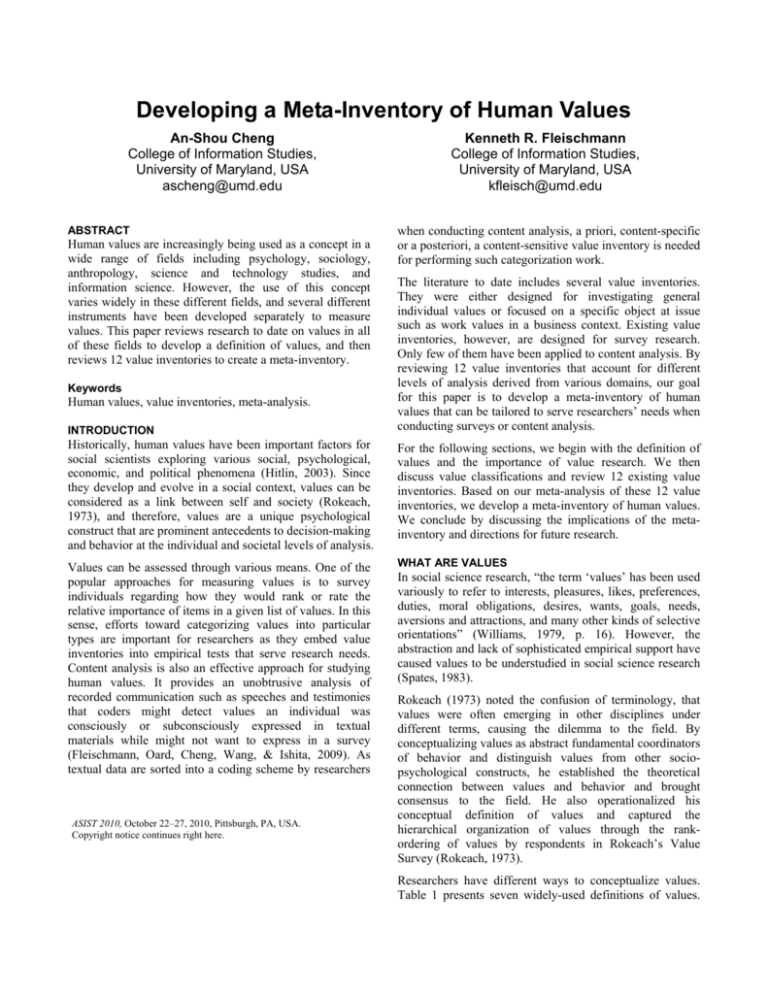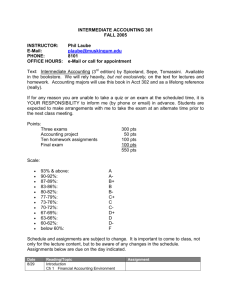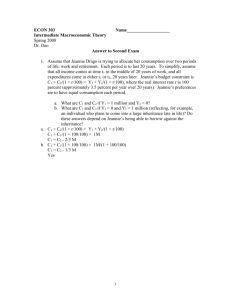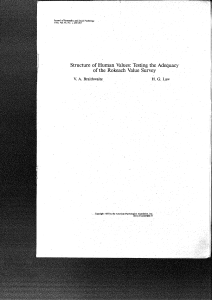Developing a Meta-Inventory of Human Values
advertisement

Developing a Meta-Inventory of Human Values An-Shou Cheng College of Information Studies, University of Maryland, USA ascheng@umd.edu ABSTRACT Human values are increasingly being used as a concept in a wide range of fields including psychology, sociology, anthropology, science and technology studies, and information science. However, the use of this concept varies widely in these different fields, and several different instruments have been developed separately to measure values. This paper reviews research to date on values in all of these fields to develop a definition of values, and then reviews 12 value inventories to create a meta-inventory. Keywords Human values, value inventories, meta-analysis. INTRODUCTION Kenneth R. Fleischmann College of Information Studies, University of Maryland, USA kfleisch@umd.edu when conducting content analysis, a priori, content-specific or a posteriori, a content-sensitive value inventory is needed for performing such categorization work. The literature to date includes several value inventories. They were either designed for investigating general individual values or focused on a specific object at issue such as work values in a business context. Existing value inventories, however, are designed for survey research. Only few of them have been applied to content analysis. By reviewing 12 value inventories that account for different levels of analysis derived from various domains, our goal for this paper is to develop a meta-inventory of human values that can be tailored to serve researchers’ needs when conducting surveys or content analysis. Historically, human values have been important factors for social scientists exploring various social, psychological, economic, and political phenomena (Hitlin, 2003). Since they develop and evolve in a social context, values can be considered as a link between self and society (Rokeach, 1973), and therefore, values are a unique psychological construct that are prominent antecedents to decision-making and behavior at the individual and societal levels of analysis. For the following sections, we begin with the definition of values and the importance of value research. We then discuss value classifications and review 12 existing value inventories. Based on our meta-analysis of these 12 value inventories, we develop a meta-inventory of human values. We conclude by discussing the implications of the metainventory and directions for future research. Values can be assessed through various means. One of the popular approaches for measuring values is to survey individuals regarding how they would rank or rate the relative importance of items in a given list of values. In this sense, efforts toward categorizing values into particular types are important for researchers as they embed value inventories into empirical tests that serve research needs. Content analysis is also an effective approach for studying human values. It provides an unobtrusive analysis of recorded communication such as speeches and testimonies that coders might detect values an individual was consciously or subconsciously expressed in textual materials while might not want to express in a survey (Fleischmann, Oard, Cheng, Wang, & Ishita, 2009). As textual data are sorted into a coding scheme by researchers WHAT ARE VALUES ASIST 2010, October 22–27, 2010, Pittsburgh, PA, USA. Copyright notice continues right here. In social science research, “the term ‘values’ has been used variously to refer to interests, pleasures, likes, preferences, duties, moral obligations, desires, wants, goals, needs, aversions and attractions, and many other kinds of selective orientations” (Williams, 1979, p. 16). However, the abstraction and lack of sophisticated empirical support have caused values to be understudied in social science research (Spates, 1983). Rokeach (1973) noted the confusion of terminology, that values were often emerging in other disciplines under different terms, causing the dilemma to the field. By conceptualizing values as abstract fundamental coordinators of behavior and distinguish values from other sociopsychological constructs, he established the theoretical connection between values and behavior and brought consensus to the field. He also operationalized his conceptual definition of values and captured the hierarchical organization of values through the rankordering of values by respondents in Rokeach’s Value Survey (Rokeach, 1973). Researchers have different ways to conceptualize values. Table 1 presents seven widely-used definitions of values. One of the differences among scholars is the collective terms used to describe values. Rokeach (1973) and Schwartz (1994) view values as “enduring belief” while Kluckhohn (1951) and Guth and Tagiuri (1965) see values as a “conception” and Braithwaite and Blamey (1988) view values are “principles.” Source Rokeach (1973) Schwartz (1994) Kluckhohn (1951) Guth & Tagiuri (1965) Definition “A value is an enduring belief that a specific mode of conduct or end-state of existence is personally or socially preferable to an opposite or converse mode of conduct or end-state of existence” (p. 5). A value is “a belief pertaining to desirable end states or modes of conduct that transcends specific situations; guides selection or evaluation of behavior, people, and events; and is ordered by the importance relative to other values to form a system of value priorities” (p. 20). A value is “a conception, explicit or implicit, distinctive of an individual, or characteristic of a group, of the desirable which influences the selection from available modes, means, and ends of action” (p. 395). “A value can be viewed as a conception, explicit or implicit, of what an individual or a group regards as desirable, and in terms of which he or they select, from among alternative available modes, the means and ends of action” (pp. 124-125). Hutcheon (1972) “…values are not the same as ideals, norms, desired objects, or espoused beliefs about the 'good', but are, instead, operating criteria for action…” (p. 184). Braithwaite & Blamey (1998) “Values…are principles for action encompassing abstract goals in life and modes of conduct that an individual or a collective considers preferable across contexts and situations” (p. 364). Friedman, Kahn, & Borning (2006) “A value refers to what a person or group of people consider important in life” (p. 349). Table 1. The Selection of Definitions for “Values” Our summation of these definitions is that “values serve as guiding principles of what people consider important in life.” Although the notion of values as guiding principles is literately taken from Braithwaite and Blamey (1988) and the notion that values are what people consider important in life is taken from Friedman, Kahn, and Borning (2006), our definition is also influenced by Rokeach (1973), Schwartz (1994), Kluckhorn (1951), Guth and Tagiuri (1965), and Hutcheon (1972) as they imply that values are what people regards as desirable and guide selections or evaluation of action. THE IMPORTANCE OF VALUES RESEARCH Values have been an important socio-psychological construct in social science research. The view that values motivate and explain individual decision-making has been widely accepted and values have been acknowledged as a key predictive and explanatory factor in investigating human and social dynamics (Schwartz, 2007). Literature from psychology, sociology, organizational behavior, and political science has suggested that values may underlie and explain a variety of individual and organizational behaviors. In the field of psychology, values have been found to be related to personality types (Allport, Vernon, & Lindzey, 1960). In sociology, values have been thought to be useful for describing society’s collective consciousness (Durkheim, 1960). In organizational behavior, values influence corporate decisions on strategy (England, 1967) and organizational commitment (Ponser & Schmidt, 1993). In political science, values serve as significant predictors of attitudes toward governmental policies, political parties, and institutions (Schwartz, 2007). To sum up, the importance of values in human and social dynamics is best illustrated by the following statements: Values are determinants of virtually all kinds of behavior that could be called social behavior or social action, attitudes and ideology, evaluations, moral judgments and justifications of self to others, and attempts to influence others (Rokeach, 1973, p. 5). VALUE CLASSIFICATIONS Many research efforts on values have been devoted to understand the structure and classification of values. Rokeach (1973) identified 36 values which are organized into terminal and instrumental values. Schwartz (1994) specifies 56 basic human values that can be grouped into 10 value types. In this sense, the ways used to characterize values include “efforts toward enumerating the theoretically limited number of values that exist in the world and efforts toward categorizing those values into particular types” (Henry & Reyna, 2007, p. 274). Value classifications can be approached from various perspectives. As Rescher (1969) argued, consideration of different aspects of classifications can shed further light on understanding the concept of values. He proposed six principles as criteria for classifying values. These principles show that value classifications can be approached from many directions. He differentiated values by (1) the subscribership to the value, in which values can be grouped as personal values, professional or work values, national values, etc; (2) the objects at issue, in which values can be classified with respect to their appropriate group of objects such as thing values, environmental values, individual or personal values, group values, and societal values; (3) the sort of benefits at issue, in which values can be projected into a corresponding classification such as material and physical, economic, moral, social, political, aesthetic, religious (spiritual), intellectual, professional, and sentimental; (4) the sort of purposes at issue, in which values can be classified according to the specific type of purpose served by realization of the valued context, such as the bargaining value of a certain resource, or the persuasive value of an argument; (5) the relationship between subscriber and beneficiary, in which values can be classified as self-oriented (or egocentric) values and otheroriented (or disinterested) values; (6) the relationship of the value to other values. In this approach certain values are viewed as subordinate to other values. The subordinate values may be classified as instrumental or mean values. Self-sufficient values, which are not viewed as subordinate, can be classified as intrinsic or end values. Since our definition stipulates that values “serve as guiding principles of what people consider important in life,” this study only focused on “the sort of benefits at issue,” in which values are classified according to human wants, needs, and interests that are served by their realization. CHRONOLOGICAL INVENTORIES OVERVIEW OF VALUE Researchers from various domains have aimed to analyze the structure and classification of values by proposing and developing value inventories that can be adopted in values research. By value inventories, we mean that they are lists of items that provide explicit categories for the analysis of human values. These inventories vary in terms of their origins, purposes, the principles of organizing values, the items of values proposed, and their applications. A value inventory not only displays what values categories are available for analysis but also provides a descriptive tool for researchers to locate their discussions of values. As we are interested in precise basic human values rather than general value dimensions, only value inventories with distinct categories will be considered. The level of abstraction is an important criterion for selection of value inventories. As such, some prominent values research that did not provide sufficiently explicit value categories are not selected for this study. For example, Allport et al. (1960) classified six types of values: (1) theoretical, (2) economic, (3) aesthetic, (4) social, (5) political, and (6) religious; Inglehart’s (2008) World Values Survey which identified two major dimensions of cross-cultural variation: (1) Traditional/Secular-rational values and (2) Survival/Selfexpression values; and Hofstede’s (1980) work on organizational cultures which identified four dimensions works values: (1) power distance, (2) uncertainty avoidance, (3) individualism versus collectivism, and (4) masculinity versus femininity. Based on the above criteria, the value inventories reviewed in this study are: (1) Value hierarchy for management decisions (Bernthal, 1962), (2) Personal Value Scale (Scott, 1965), (3) Personal Values Questionnaire (England, 1967), (4) Rokeach Value Survey (Rokeach, 1973), (5) List of Values (Kahle, Poulos, & Sukhdial, 1988), (6) Comparative Emphasis Scale (Ravlin & Meglino, 1987), (7) Managerial moral standards (Bird & Waters, 1987), (8) Shared values in organizations (McDonald & Gandz, 1991), (9) Schwartz Value Survey (Schwartz, 1994), (10) Life Values Inventory (Crace & Brown, 1995), (11) Workplace spirituality values (Jurkiewicz & Giacalone, 2004), and (12) Value Sensitive Design (Friedman et al., 2006). The value inventories presented in this study are by no means exhaustive. Value Hierarchy for Management Decisions (Bernthal, 1962) Bernthal (1962) proposed a model of a hierarchy of values for management decisions that was based on purely rational reasoning. Based on the value hierarchy he proposed, a manager should be aware of not only the economic consequences of his decision, but also the consequences in terms of different levels of values. The model includes four levels of values that account for decision criteria that should be applied: • The business firm level: decision makers seek profits, survival, and growth to ensure ownership welfare. • The economic system level: decision makers value allocation of resources, production and distribution of goods and services to pursue consumer welfare. • The society level: decision makers seek “the good life”, culture, civilization, order, and justice to preserve social welfare. • The individual level: decision makers emphasize on freedom, opportunity, self-realization, and human dignity to pursue individual welfare. Personal Value Scale (PVS) (Scott, 1965) The Personal Value Scale (PVS) is an instrument Scott (1965) designed for examining an individual’s concept of ideal relations among people or ideal personal traits. Twelve values were identified through an open-question survey of college students by asking what traits they admire in others. A multi-question instrument was then constructed to measure the values that may be professed by students. The PVS was used to analyze values of individual level as expressed in interpersonal relations. Each value item has short definition and followed by several example questions. Twelve value items in the PVS are: (1) intellectualism, (2) kindness, (3) social skills, (4) loyalty, (5) academic achievement, (6) physical development, (7) status, (8) honesty, (9) religiousness, (10) self-control, (11) creativity, and (12) independence. Personal Values Questionnaire (PVQ) (England, 1967) The Personal Values Questionnaire (PVS) is an instrument England (1967) designed for use in a business context to study the value systems of business managers. It was designed from an item pool of 200 concepts selected from the literature dealing with organizations and with individual and group behavior, then the list was refined down to 66 concepts through expert judges and a pilot study of managers. In the PVS, 66 value concepts were organized into five categories to distinguish values of individuals, organizational goals, and personal goals. However, some concepts do not in and of themselves constitute values. For example, employees, customers, and government are concepts specified as groups of people that are not valueladen. The PVS contains the following 66 value items organized by five categories: • Goals of business organizations: high productivity, industry leadership, employee welfare, organizational stability, profit maximization, organizational efficiency, social welfare, and organizational growth. • Personal goals and individuals: leisure, dignity, achievement, autonomy, money, individuality, job satisfaction, influence, security, power, creativity, success, and prestige. security, self-respect, health, a comfortable life, freedom, salvation, equality, wisdom, a world at peace, and a world of beauty. • Instrumental values: ambitious, broad-minded, capable, clean, cheerful, courageous, forgiving, helpful, honest, imaginative, independent, intellectual, logical, loving, obedient, polite, responsible, and self-controlled. List of Values (LOV) (Kahle et al., 1988) Kahle et al. (1988) designed the List of Values (LOV) to measure consumer attitudes and behavior. It is focused on personal values that apply to people’s daily lives. The LOV contains nine values which were derived from Rokeach’s list of 18 terminal values, Maslow’s (1954) hierarchy of needs, and other values research literature. It has been widely used in advertising and marketing research as well as other fields. • Groups of people: employees, customers, my co-workers, craftsman, my boss, managers, owners, my subordinates, laborers, my company, blue collar workers, government, stockholders, technical employees, me, labor unions, and white collar employees. The LOV is based on the importance of people in value fulfillment (Kahle et al., 1988). For example, values can be fulfilled through interpersonal relationships (warm relationships, sense of belonging), personal factors (selffulfillment, being-well respected), or other needs (security, excitement, fun and enjoyment). • Ideas associated with people: ambition, ability, obedience, trust, aggressiveness, loyalty, prejudice, compassion, skill, cooperation, tolerance, conformity, and honor. Nine values make up the LOV: (1) fun and enjoyment, (2) warm relationships, (3) self-fulfillment, (4) being wellrespected, (5) sense of accomplishment, (6) security, (7) self-respect, (8) sense of belonging, and (9) excitement. • Ideas about general topics: authority, caution, change, competition, compromise, conflict, conservatism, emotions, equality, force, liberalism, property, rational, religion, and risk. Rokeach Value Survey (RVS) (Rokeach, 1973) The Rokeach’s Value Survey (RVS) is a value system Rokeach (1973) established for a theoretical connection between values and behavior. Through the RVS, Rokeach operationalized the conceptual definition of values and established the hierarchical organization of values. Values proposed in the RVS were selected largely on an intuitive basis after reviewing literature on values and personality traits (Rokeach, 1973). The RVS has been widely used in psychology and become the basis of other value instruments. The RVS was constructed to distinguish between terminal and instrumental values. In the proposed value system, terminal values are ultimate goals that may be self-centered or society-centered, intrapersonal or interpersonal, while instrumental values are standards that guide conduct of behavior and consist of moral values and competence values (Rokeach, 1973). The RVS contains the following 36 value items organized into terminal and instrumental values: • Terminal values: an exciting life, pleasure, mature love, true friendship, inner harmony, social recognition, a sense of accomplishment, family security, national Comparative Emphasis Scale (CES) (Ravlin & Meglino, 1987) The Comparative Emphasis Scale (CES) is designed to examine the impact of work values on perception and decision-making tasks. It was designed through surveys of 966 employees at different levels in a variety of organizations and the results of the surveys were sorted into separate value categorized by six independent expert judges (Ravlin & Meglino, 1987). The CES assesses individual preferences and organizational values along the same dimension, enabling examinations of congruence between individual and organization. Four work values identified in the CES are: (1) achievement, (2) helping (concern for others), (3) honesty, and (4) fairness. Managerial Moral Standards (Bird & Waters, 1987) Bird and Waters (1987) identified and analyze the moral standards held by managers in their work life. They first interviewed managers to discuss moral issues that have arisen in their daily work and then identified predominant features of these discussions to synthesize normative morale standards invoked by managers. These managerial moral standards have been applied to managerial ethical decisions and business ethic research. In comparison to Bernthal’s (1962) values for management decisions that distinguishes four levels of values, the managerial morale standards proposed by Bird and Waters is focused on individual level’s moral standards in everyday decision-making. The values for managerial moral standards are: (1) honesty in communication, (2) fair treatment, (3) special consideration, (4) fair competition, (5) organizational responsibility, (6) corporate social responsibility, and (7) respect for law. conservation to openness to change and the other dimension is defined by the spectrum from self-enhancement to selftranscendence (Schwartz, 1994). The SVS contains the following 56 basic human values categorized into 10 value types (Schwartz, 1994): • Power: social power, authority, wealth, preserving my public image, and social recognition. Shared Values in Organizations (McDonald & Gandz, 1991) • Achievement: successful, capable, ambitious, influential, intelligent, and self-respect. McDonald and Gandz (1991) developed a comprehensive list of organizational values that can account for individual values in relation to organization needs. They first conducted 45 in-depth interviews with people from within and outside of organizations and then used content analysis to generate a pool of value items from the qualitative data. The 358 items generated form the interviews were then selected and aggregated into 24 shared values applicable to business context according to authors’ judgments using root concepts from the thesaurus. McDonald and Gandz’s list of values has been applied to organizational values and human resources research. • Hedonism: pleasure, and enjoying life. McDonald and Gandz (1991) identified a three-level classification structure linking stakeholder needs, organizational goals, and shared values. They suggested further empirical studies to examine the relationships across these three levels and indicated that individualorganizational value congruence can be assessed through the proposed list of shared values. • Tradition: devout, accepting portion in life, humble, moderate, respect for tradition, and detachment. The 24 shared values in organizations proposed by McDonald and Gandz (1991) are: (1) adaptability, (2) aggressiveness, (3) autonomy, (4) broad-mindedness, (5) cautiousness, (6) consideration, (7) cooperation, (8) courtesy, (9) creativity, (10) development, (11) diligence, (12) economy, (13) experimentation, (14) fairness, (15) forgiveness, (16) formality, (17) humor, (18) initiative, (19) logic, (20) moral integrity, (21) obedience, (22) openness, (23) orderliness, and (24) social equality. Schwartz Value Survey (SVS) (Schwartz, 1994) The Schwartz Values Survey (SVS) is an instrument Schwartz (1994) created as a result of value surveys conducted through 20 countries as well as a thorough study of psychological value theories. The SVS specifies the dynamic relations among the motivational value types leading to a three-level hierarchy containing 56 basic human values. It provides a conceptual framework that is culturally universal in its context and structure. The SVS has both theoretical and empirical grounds and has been applied to various domains such as psychology and political science research. The SVS was organized in a three-level hierarchy, including 4 1st-level “value dimensions,” 10 2nd-level “value types,” and 56 3rd-level “basic human values.” These value types can be visualized in a two-dimensional space where one dimension is defined by the spectrum from • Stimulation: daring, a varied life, and an exciting life. • Self-direction: creativity, curious, freedom, choosing own goals, and independent. • Universalism: protecting the environment, a world of beauty, unity with nature, broad-minded, social justice, wisdom, equality, a world at peace, and inner harmony. • Benevolence: helpful, honest, forgiving, loyal, responsible, true friendship, a spiritual life, mature love, and meaning in life. • Conformity: politeness, honoring of parents and elders, obedient, and self-discipline. • Security: clean, national security, social order, family security, reciprocation of favors, healthy, and sense of belonging. Life Values Inventory (LVI) (Crace & Brown, 1995) The Life Values Inventory (LVI) is developed by Crace and Brown (1995) to assess values that guide behavior and decision-making. It contains 14 values that was generated from an initial pool of 190 items selected from values literature and has been validated through pilot studies and evaluated by domain experts. The LVI has been used in counseling, therapy, and team development (Brown & Crace, 2002). The LVI explains values in decision-making process and the satisfaction that results from roles related decisions. It tries to identify the congruence between individual’s values and the roles of those individuals in a society and attempts to bridge the gap between work values inventories and general values inventories (Brown & Crace, 2002). The 14 value items in the LVI are: (1) achievement, (2) belonging, (3) concern for the environment, (4) concern for others, (5) creativity, (6) financial prosperity, (7) health and activity, (8) humility, (9) independence, (10) interdependence, (11) objective analysis, (12) privacy, (13) responsibility, and (14) spirituality. The Value Framework of Workplace (Jurkiewicz & Giacalone, 2004) Spirituality Jurkiewicz and Giacalone (2004) proposed a framework of organizational values that promote employees’ experience of transcendence through the work process. The values selected in the framework are largely based on an intuitive basis culled from the theoretical work on workplace spirituality and have a positive impact on employee and organizational performance. Jurkiewicz and Giacalone (2004) argued that varying degrees of values of workplace spirituality can be recognized in an organization through its work process, policies, and practices. The values proposed by Jurkiewicz and Giacalone (2004) are: (1) benevolence, (2) generativity, (3) humanism, (4) integrity, (5) justice, (6) mutuality, (7) receptivity, (8) respect, (9) responsibility, and (10) trust. Value Sensitive Design (VSD) (Friedman et al., 2006) Value Sensitive Design (VSD) was created by Friedman et al. (2006) for examining human values implicated in technology design. It was derived from an integrative and iterative tripartite methodology consisting of conceptual, empirical, and technical investigations and has been applied to human-computer interaction and information science. The VSD not only focused on the usability principles that underpinning the design of technology but also accounts for the ethical values in a principled and comprehensive manner throughout the design process. In contrast to traditional criteria of system design which is focused on usability, reliability, and correctness, the VSD emphasized the needs for human values with ethical import as a central design criterion (Friedman et al., 2006). Key values the VSD identified for design and use of technology are: (1) human welfare, (2) ownership and property, (3) privacy, (4) freedom from bias, (5) universal usability, (6) trust, (7) autonomy, (8) informed consent, (9) accountability, (10) courtesy, (11) identity, (12) calmness, and (13) environmental sustainability. META-ANALYSIS OF VALUE INVENTORIES Examining the 12 value inventories presented in previous section, three approaches of designing value inventories can be identified: (1) rational-theoretical inventories, (2) empirical-based inventories, and (3) theoretical-empirical inventories. • Rational-theoretical inventories could be conceptualized based on purely rational or a priori inventories. For example, Bernthal’s (1962) work on value hierarchy for management decisions, the PVQ (England, 1967), the RVS (Rokeach, 1973), the LOV (Kahle et al., 1988), and Jurkiewicz and Giacalone’s (2004) value framework of workplace spirituality are rational-theoretical inventories. • Empirical-based inventories imply that value items are directly derived from empirical data based on survey, interview, or content analysis. For example, the PVS (Scott, 1965), the CES (Ravlin and Meglino, 1987), and Bird and Waters’s (1987) managerial moral standards are empirical-based inventories. • Theoretical-empirical inventories are developed through an initial rational or theoretical selection of items that can be put into an empirical test to get results. For example, McDonald and Gandz’s (1991) shared values in organizations, the SVS (Schwartz, 1994), the LVI (Crace & Brown, 1995), and the VSD (Friedman et al., 2006) are theoretical-empirical inventories. Among these three approaches of value inventory design, scholars express concern about the subjectivity that a rational-theoretical inventory could have in identifying the value items and the number of values to be included in the inventory. Hofstede (1980) noted that “inspection of number of instruments designed to measure human values makes it clear that the universe of all human values is not defined and that each author has made his or her own subjective selection from this unknown universe, with little consensus among authors” (p.22). Braithwaite and Law (1985) also questioned the reliance on literature searches, on previous questionnaires, or on the researcher’s intuitions in search for a useful set of values because they do not necessarily result in the identification of values that are meaningfully for the population of interest. In addition to inventory designing approaches, these 12 value inventories can be compared on the basis of their underlying structures and level of analysis. Generally speaking, the PVS (Scott, 1965), the RVS (Rokeach, 1973), the SVS (Schwartz, 1992), and the LVI (Crace & Brown, 1995) are designed to measure general individual values; The PVQ (England, 1967), Bernthal’s (1962) value hierarchy for management decisions, McDonald and Gandz’s (1991) shared values in organizations, Bird and Waters’s (1987) managerial moral standards, and are designed to measure managerial values; The CES (Ravlin and Meglino, 1987), and Jurkiewicz and Giacalone’s (2004) value framework of workplace spirituality are designed to measure work values; The LOV (Kahle et al., 1988) is designed to measure consumer values, and the VSD (Friedman et al., 2006) is designed for technology design. Specifically, Bernthal’s (1962) value hierarchy for management decisions, and McDonald and Gandz’s (1991) shared values in organizations provide hierarchical structure to address different levels of values. Unlike Bernthal’s (1962) four distinct levels of values, McDonald and Gandz’s (1991) try to measure individual-organizational value congruence in the same dimension. The majority of these value instruments are designed for survey purpose with an exception that VSD (Friedman et al., 2006) is designed for technology and system design. Although some of these value instruments are widely used, they are not one-size-fits-all lists applicable under all circumstances. It is, therefore, important to synthesize these inventories to develop a meta-inventory that can be tailored by researchers to measure human values meet their interest. Proposed List Freedom Helpfulness Accomplishment Honesty Self-respect Broad-mindedness Creativity Equality 9 9 8 8 8 6 6 6 Tolerance Creativity Equality Broad-minded Imaginative Equality Broad-minded A Varied Life/ Creativity/ Curious Equality - Creativity - - - - Number of Corresponding Inventories Inventory PVQ RVS Corresponding Value Items Liberalism/ Autonomy Employee Welfare/ Social Welfare Achievement/ Success Freedom/ Helpful/ A Sense of Independent Salvation Accomplishment Dignity/ Prestige/ - Honor/ Individuality Self-respect/ Honest Social Recognition Self-respect/ Freedom/ SVS Independent/ Choosing Helpful Successful/ Meaning in Life Social Honest Recognition/ Preserving my Own Goals Public Image PVS Independence - LOV Autonomy - Academic Achievement Honesty Status Sense of Accomplishment/ Self-respect/ - Being Well- Self-fulfillment LVI Independence CES - VSD Autonomy Concern for Others Helping Achievement - - - Creativity - Achievement Honesty - - - - Identity - - Freedom from Bias Human Dignity - - - Broad-mindedness/ Adaptability Creativity/ Experimentation Social Equality - Special Consideration - Fair Treatment/ Fair Competition Respect Receptivity - - Human Welfare/ Universal - Usability Bernthal McDonald & Gandz Bird & Waters Jurkiewicz & Giacalone Freedom The Good Life Self-realization Autonomy Consideration - - - - - Benevolence/ Humanism respect - Informed Consent Moral Integrity/ Openness Honesty in Communication Integrity (Table Continues) - Proposed List Intelligence Responsibility Social Order Wealth Competence Justice Security Spirituality 6 6 6 6 5 5 5 5 Number of Corresponding Inventories Corresponding Value Items Inventory Profit Maximization/ Money/ Property High Productivity/ Organizational Efficiency/ Ability/ Skill/ Industry Leadership - Security Religion PVQ Rational - Organizational Stability RVS Logical/ Intellectual/ Wisdom Responsible A World at Peace - Capable - Family Security/ National Security Inner Harmony SVS Intelligent/ Wisdom Responsible Social Order/ A World at Peace Wealth Capable Social Justice Family Security/ National Security A Spiritual Life/ Inner Harmony/ Devout PVS Intellectualism - - - - - - Religiousness LOV - - - - - Security - LVI Objective Analysis Responsibility - Financial Prosperity - - - Spirituality CES - - - - - Fairness - - VSD - Accountability - Ownership and Property - - - - Justice Survival - - - Bernthal McDonald & Gandz Bird & Waters Jurkiewicz & Giacalone - - Order Profits Allocation of Resources/ Production and Distribution of Goods and Services Logic - Orderliness Economy - Fairness Respect for Law Organizational Responsibility - - - - Justice - - Corporate Social Responsibility Responsibility Table 2. A Meta-Inventory of Human Values through a Comparison of 12 Value Inventories THE META-INVENTORY OF HUMAN VALUES IMPLICATIONS AND FUTURE WORK This study builds on the 12 value inventories mentioned above to create a meta-inventory of human values. In order to maximize mutual exclusiveness as well as minimize the ambiguity and complexity of the value categories, some value categories were dropped, some were combined, and some were rephrased based on the following principles: The meta-inventory developed in this paper represents an advance in a number of respects compared with previous value inventories. First, the meta-inventory is more comprehensive but still more manageable than previous value inventories. The 16 value categories in the proposed list are aggregated from different domains that address general individual values, work values, managerial values, and values for technology design. It address human values in a more comprehensive way than inventories such as the four value items in the CES (Ravlin & Meglino, 1987) and seven values in Jurkiewicz and Giacalone’s (2004) value framework of workplace spirituality. It is also more manageable than the fine-grained 56 value items in the SVS (Schwartz, 1994) and 66 concepts in the PVQ (England, 1967), which is particularly important for applying the meta-inventory for purposes beyond survey research, such as content analysis. First, the selected value items have to be consistent with our value definition that “values serve as guiding principles of what people consider important in life”. As such, the concepts such as employees, customers, and my co-workers in the PVQ (England, 1967) were not selected. Second, as a rule of thumb, only values which were mentioned in at least five value inventories were considered. For example, the concept freedom which was mentioned in nine out of the 12 value inventories was selected as a value category while the concept obedience which was mentioned in four value inventories was not selected. Third, the selected value items were aggregated into a value category based on the similarities of concepts. For example, concepts such as freedom, liberalism, autonomy, independent, liberty, and choosing own goals mentioned in different inventories are grouped under the root concept freedom proposed in this study (see Table 2). And concepts such as capable, efficiency, ability, skill, and industry leadership are grouped and rephrased as competence because it implies a range of skill, knowledge, or ability that encompasses concepts related to various capabilities. In aggregating these concepts, some could be misled by the terms. For example, people may think organizational responsibility should be associated with the value responsibility. However, according to Bird and Waters’s (1987) definition, “organizational responsibility is associated with making decisions that reduce waste, increase efficiency, and enhance the interest of the organization as a whole” (p.9). As a result, organizational responsibility might be more relevant to competence. The comparison of the existing value inventories led to a total of 48 value concepts. Of these, 16 value concepts were found in at least five different existing value inventories. Table 2 lists these 16 value concepts: (1) freedom, (2) helpfulness, (3) accomplishment, (4) honesty, (5) selfrespect, (6) intelligence, (7) broad-mindedness, (8) creativity, (9) equality, (10) responsibility, (11) social order, (12) wealth, (13) competence, (14) justice, (15) security, and (16) spirituality. Value concepts used in fewer than five instruments include: aggressiveness, development, loving, obedience, pleasure, politeness, self-discipline, social relationship, health, influence, loyalty, nature, respect for tradition, sense of belonging, trust, aesthetic, a comfortable life, authority, calmness, caution, cooperation, forgiveness, humility, power, privacy, change, competition, compromise, courageous, horning, humor, and initiative. Second, the meta-inventory removes the ambiguity and redundancy of value categories that previous value inventories might have. It minimizes the intercorrelation between categories to make each category unique and distinct from others. For example, concepts such as achievement and success may be ambiguous when they are in the same inventory; however, by synthesizing them under the concept of accomplishment may avoid the ambiguity. This is especially important for purposes such as content analysis, where ambiguity and redundancy lead to uncertainty and disagreement in classifying values. Third, the meta-inventory is adaptable to suit the research context that researchers need for conducting various social inquiries. For example, it can be used as a meta-inventory of human values for content analysis. It can be tailored to understand the values embedded in information policy debate (Cheng et al., 2010). It can also be utilized as principles that inform system design. An important direction for future research would be to validate and refine the meta-inventory based on empirical data. For example, to refine the meta-inventory for content analysis, the existing 16 value concepts can be applied to analyze content such as testimonies from public hearings related to information policy debates (Cheng et al., 2010). Value concepts that are frequently confused by multiple annotators can be combined into broader value concepts that are better suited to this task. Value concepts that do not appear frequently in testimonies about a wide range of information policy issues can also be discarded. The end result will be an empirically-validated and refined metainventory of value concepts that can be applied in content analysis of testimonies about information policy. The same process can then be applied to create meta-inventories of value concepts for other domains. ACKNOWLEDGMENTS This material is based upon work supported in part by the National Science Foundation under Grant IIS-0729459. REFERENCES Allport, G., Vernon, P., & Lindzey, G. (1960). Study of values. Boston: Houghton Mifflin. Hutcheon, P. D. (1972). Value theory: Towards conceptual clarification. The British Journal of Sociology, 23(2), 172-187. Bernthal, W. F. (1962). Value perspectives in management decisions. Journal of the Academy of Management, 5(3), 190-196. Inglehart, R. F. (2008). Changing values among western publics from 1970 to 2006. Western European Politics, 31(1-2), 130-146. Bird, F., Waters, J. A. (1987). The nature of managerial moral standards. Journal of Business Ethics, 6 (1), 1-13. Jurkiewicz, C. L., & Giacalone, R. A. (2004). A value framework for measuring the impact of workplace spirituality on organizational performance. Journal of Business Ethics, 49(2), 129-142. Braithwaite, V. A., & Blamey, R. (1998). Consensus, stability and meaning in abstract social values. Australian Journal of Political Science, 33, 363-380. Braithwaite, V. A., & Law, H. G. (1985). Structure of human values: Testing the adequacy of the Rokeach Value Survey. Journal of Personality and Social Psychology, 49(1), 250-263. Brown. D. & Crace, R. K. (2002). Life values inventory: Facilitator’s guide. Retrieved February 19, 2010 from http://www.lifevaluesinventory.com Cheng, A.-S., Fleischmann, K. R., Wang, P., Ishita, E., & Oard, D. (2010). Values of stakeholders in the Net neutrality debate: Applying content analysis to telecommunications policy. Proceedings of the 43rd Hawai’i International Conference on System Sciences (HICSS), Kauai, HI. Crace, R. K. & D. Brown. (1995). Life values inventory. Minneapolis: National Computer Systems. Durkheim, E. (1960). The division of labor in society. Glencoe, Ill.: Free Press. England, G.W. (1967). Personal value systems of American managers. Academy of Management Journal, 10, 53-68. Fleischmann, K. R., Oard, D. W., Cheng, A.-S., Wang, P., & Ishita, E. (2009). Automatic classification of human values: Applying computational thinking to information ethics, Proceedings of the 72nd Annual Meeting of the American Society for Information Science and Technology (ASIS&T), Vancouver, Canada. Friedman, B., Kahn, P. H., Jr., & Borning, A. (2006). Value sensitive design and information systems. In P. Zhang & D. Galletta (Eds.), Human-computer interaction in management information systems: Foundations (pp. 348372). New York: M. E. Sharpe. Guth, W. D., & Tagiuri, R. (1965). Personal values and corporate strategy. Harvard Business Review,43,123-132. Henry, P. J., & Reyna, C. (2007). Value judgments: The impact of perceived value violations on American political attitudes. Political Psychology, 28(3), 273-298. Hitlin, S. (2003). Values as the core of personal identity: Drawing links between two theories of self. Social Psychology Quarterly, 66(2), 118-137. Hofstede, G. (1980). Culture’s consequences: International differences in work related values. Beverly Hills, CA: Sage. Kahle, L. R., Poulos, B., & Sukhdial, A. (1988). Changes in social values in the United States during the past decade. Journal of Advertising Research, 28, 35-41. Kluckhohn, C. (1951). Values and value-orientations in the theory of action. In T. Parsons, and E. A. Shils (eds.), Toward a General Theory of Action (pp. 388-433). Cambridge, MA: Harvard University Press. Maslow, A. H. (1954). Motivation and personality. New York: Harper. McDonald, P., & Gandz, J. (1991). Identification of values relevant to business research. Human Resource Management, 30(2), 217-236. Ponser, B. Z., & Schmidt, W. H. (1993). Values congruence and differences between the interplay of personal and organizational value systems. Journal of Business Ethics, 12, 341-347. Ravlin, E. C., & Meglino, B. M. (1987). Effect of values on perception and decision making: A study of alternative work values measures. Journal of Applied Psychology, 72, 666-673. Rescher, N. (1969). Introduction to value theory. Englewood Cliffs, NJ: Prentice-Hall, Inc. Rokeach, M. (1973). The nature of human values. New York: Free Press. Schwartz, S. H. (1994). Are there universal aspects in the structure and contents of human values? Journal of Social Issues, 50(4), 19-45. Schwartz, S. H. (2007). Value orientations: measurement, antecedents and consequences across nations. In R. Jowell, C. Roberts, R. Fitzgerald, & G. Eva (Eds.), Measuring Attitudes Cross-Nationally: Lessons from the European Social Survey (pp. 169-203). London: Sage. Scott, W. A. (1965). Values and organizations: A study of fraternities and sororities. Chicago: Rand McNally. Spates, J. L. (1983). The sociology of values. Annual Review of Sociology, 9, 27-49. Williams, R. M. Jr. (1979). Change and stability in values and value systems: A sociological perspective. In M. Rokeach (Ed.), Understanding human values (pp.15-46). New York: The Free Press.







